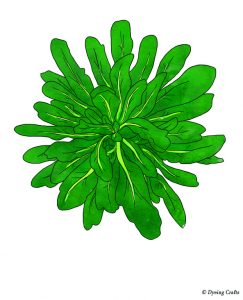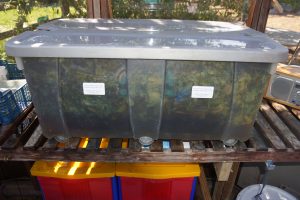
Woad Week
| 12th August 2018Several people have asked how to grow, process and dye with woad.
Woad is a hardy biennial plant, native to northern Europe and the British Isles. It is the source of the blue dye chemical – indigotin.
It is very easy to grow. It is the first year’s leaves which are harvested for dyeing.

The second year is when it flowers, it looks very pretty and the bees love it!

Last years woad coming into flower
The flower is short lived (about 3 – 4 weeks) and then it produces huge quantity of seeds.

Woad seeds are sown in March or November, thinly spaced and just covering the seed with a fine layer of soil. Transplant them when large enough to handle. Woad prefers an alkaline soil so apply lime about a week or so before transplanting.
Woad planted in November is ready for harvesting from June/July and woad planted in March is ready from August until October.
BUY WOAD SEEDS FROM MY ONLINE STORE
There are several recipes for extracting the woad pigment – the following is a method I use successfully each year.
I collect enough leaves to half fill a 30 litre plastic container, wash them carefully and roughly tear them into several pieces.

I heat up in my Burco water boiler with rain water to 90 degrees Centigrade – enough to cover the leaves. You can work on a smaller scale following the same method.
When the water has reached temperature I pour it into the plastic container and cover the leaves, clip on the cover and allow it to steep until the water has cooled down.

When the liquid reaches about 55 degrees centigrade I strain the leaves through a cheesecloth draped over a colander and compost the spent leaves.
You now need to make the solution alkaline. I add ammonia to give me a pH reading of between 9 and 10. You can also use soda ash or washing soda to increase the pH. The liquid will turn to a green/brown colour. The vat now needs to be aerated. You can do this by using an electric or manual whisk for about 10 minutes. I use an aquarium aerator as I am working with a large volume of liquid – this saves me a great deal of time.

Once oxidized I leave it undisturbed for a few hours, allowing the pigment to settle. I leave mine overnight and then siphon off about ¾ of the water with a hose trying not to disturb the pigment at the bottom of the container.
I then top the container up with fresh water and allow the pigment to settle at the bottom again. I repeat this process several times until the water above the sediment eventually stays clear. Finally, I siphon off most of the water leaving a small amount containing the pigment which I filter through a double layer of filter papers. This can take 24 hours or longer to complete by which time you are left with a beautiful dark blue sludge – your woad pigment!


I then dry the paste by transferring it to Teflon woks and allowing it to dry over a period of days.

When completely dry it peels away from the wok very easily and can be ground into a fine powder and stored until ready to use. I use a dedicated blender for this purpose but a pestle and mortar also works very well.
1 gram of woad will dye approximately 20 grams of fibre
Woad works on wool, silk and cotton. Combined with the red of madder root, it produces purple and when overdyed with weld produces green.






